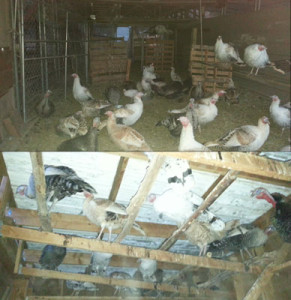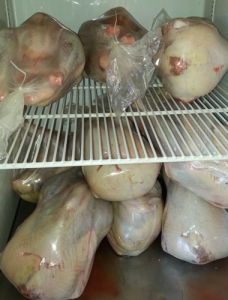Turkey Proliferation
I think I have more turkeys now than when I started slaughtering before Thanksgiving. Okay, I know that’s not true but it sure feels like it. I think I miscounted, which is easy to do with turkeys as they refuse to stand still and so I can count them. I even tried counting at night while they’re roosting, but the minute I start moving toward the back of the coop, birds leap off roosts and start milling in agitation. When you have (apparently) a hundred birds, that’s a lot of milling.
This is how it works with turkeys. Around early April the hens finish laying their eggs–anywhere from 15 to 25 of them. That means they started popping out those cute brown-speckled ovoids near the beginning of March. This last year I started with 20 hens and they scattered to every corner of the property to nest. They love the blackberries, unfortunately. What keeps me out also keeps out most of the predators. There were even a couple outside the fence in the vegetation by the road. I found one and built a box around her, but I didn’t find the other one until she’d hatched out her babies and was trying to find a way to rejoin the flock.
Mind you, once the girls start sitting, they don’t move for about 21 days–no food, no water, no nothing. Then all of a sudden at day 21 a motley, skinny bird appears at the food dish and gobbles (pun intended) down as much as she can in three minutes, slurps up some water, then disappears again. That’s how I know hatching is imminent and to start watching for the babies, who dutifully begin appearing 7 days later. If all the eggs haven’t hatched out by day 30, Mom leaves the nest, abandoning the other eggs even if they’re viable. That’s what broody hens are for. I had one who happily hatched 7 babies for me. I just kept putting the peeping eggs under her. (A day or two before they hatch, both chicks and poults will start peeping inside the egg. Did I mention that baby turkeys are called “Poults” and that’s the root of our word “Poultry”?)
Anyway, most of the first clutches are hatched out by the end of April. That’s their natural cycle, which really does make them the perfect bird for Thanksgiving because they’re full grown by the end of November. So April was when I first started counting beaks. By May I was pretty sure I had 150 birds. Ten or so floated away down the ditch as their mothers tried to convince them they could fly using their little Tyrannosaur appendages. Another ten either drowned in the water troughs (they’ll jump up on the edge, teeter a bit then fall in) or were knocked on their backs and couldn’t right themselves. As I’ve mentioned before, this is a serious turkey design flaw. I spend a great deal of time in those first weeks watching for overturned poults.
By the beginning of June I was pretty sure I had 140 birds. They certainly ate like that many birds. I’m so glad I don’t do confinement farming because the food costs would be astronomical. It’s far cheaper to let them graze on grass and bugs, and my cherry tomatoes dang it. By August there’d been a few dog malfunctions–17 birds this year, but he’s doing so much better that I’m starting to think he’s finally got it, by George!–and a good deal of mountain lion and/or bobcat intrusion. By that I mean I thought I was down to 80 birds.
Then Thanksgiving came and went and I know how many I slaughtered. After that I started frowning at the food bowls. Not much relief on that front. So I took another eight birds on Friday, just for broth and ground meat. That should have taken me to less than 40 birds. But I keep looking and counting as best I can as they dash and dart around me. I swear I’m still over 50 birds. What?! Were they hiding on the hillside until Thanksgiving passed and are just now returning to the coop? How did I miscount by that much?
Oh, wait! That’s right, I can’t count. I have Dyscalculi. That’s Dyslexia for numbers. I struggle with numbers because they jumble and shift in front of my eyes.
Well, no matter how many there are, I need to be down to 20 hens and Tom by the year’s end. It took me 3 hours to process the last 8 birds. If I do 8 every fifth day, I can shrink wrap the previous set of eight using the hot water in the scalder before I start plucking the next set.
Why am I waiting five days between batches, you might ask. This appears to be a little known fact, even among people I expect would know this. So here it is: Birds, just like beef, need to process for a few days after death before they’re edible. While beef hangs–or used to hang for a couple of weeks while processing; now all but the small slaughterhouses use chemicals for force the meat to soften before its time–birds need to be kept refrigerated for at least three days while rigor mortis passes. So the birds you buy in the supermarket are either shot up with softening chemicals or have been sitting for probably a week before they even hit the wrapping machine. Things that make you go “hmm”…


